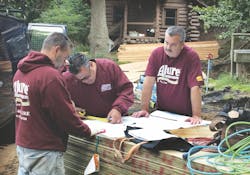It’s hard to turn a profit when you go over budget. In 2017, I realized that we were regularly coming up short in budgeting for certain things (most notably electric) and losing out on revenue.
It came down to a lack of collaboration between sales and production. We’re all working to create an end product the client loves, but how each side does so doesn’t always mesh.
So, I implemented a zero-tolerance policy for budget overruns. Here are the three key steps we took to create and enforce our zero-tolerance policy:
1] Let production see the design early. Part of solving a problem is working to prevent that problem. Under our policy, production first sees the design when they receive the project folder for review, before the pre-construction check-out. Nothing has been ordered yet, and the project manager has time to offer advice and suggestions.
Once measuring and walk-throughs have been done, another discussion takes place to ensure all design specs will work as drawn. Return trips for punch lists and manufacturer issues tend to be where budgets are busted when a client doesn’t approve additional charges, so this step looks to prevent those from happening.
Stopping work so sales and production can meet sounds like it would slow down the project, but it’s had the opposite effect ... we typically need only one meeting to solve an unforeseen issue.
2] Require sales and production to meet. After those initial reviews, if a PM realizes there isn’t enough money in the budget, he or she has to bring back the salesperson to collaborate on a new solution. Finishing on time doesn’t garner PMs a bonus, so rushing through benefits no one.
Whether the solution is adjusting the budget, the client’s expectations, or the design, these two teams have to get the project back on budget before continuing—no exceptions. Having them collaborate allows production to explain the cost issues and sales to further flush out the thought behind the design.
Stopping work so sales and production can meet (either in person or via phone) sounds like it would slow down the project, but it’s had the opposite effect. We’ve found that in the later stages of a project, we typically need only one meeting to solve an unforeseen issue. At most we’ve needed two.
If the project manager and salesperson can’t reach an agreement on how to get back on budget, we would bring in upper management. It’s a testament to how well this system works, and how seriously our team takes the policy, that we haven’t yet had to do that.
3] Encourage shared learning.
Sometimes cost overruns come from a mistake on one side or the other, but it can also result from job conditions or an issue with the client. At the end of the day it doesn’t matter where a problem started, but rather how the team learns to solve it.
Employees will find a way to make it work, as a team, because everyone is shooting for the same goal: happy customer, profitable project.
About the Author

Sal Ferro
Sal Ferro is the president and CEO of Alure Home Improvements in East Meadow, N.Y.
